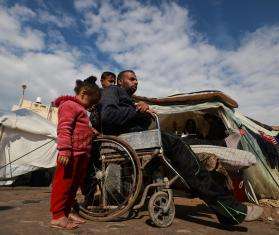Doctors Without Borders/Médecins Sans Frontières (MSF) has been equipped for more than three years with inflatable tents enabling rapidly and adaptable set-ups of operating suites, intensive care units, and hospital beds. Injured patients in Gaza City who require specialized or follow-up surgical procedures are admitted to such a temporary hospital. Dr. Mego Terzian, MSF deputy coordinator for emergency programs explains more.
What do temporary hospitals look like?
From the outside, these are two enormous white tents, each one measuring 100m², quite similar in appearance to a typical tent. While the structure supporting the roof is made of inflatable tubes, the tent interior is arranged according to need. In the case of Gaza, we implemented two operating suites and one 12-bed post-operative care unit. Logisticians needed only 48 hours to erect the tents, during which time part of the surgical team worked on recruiting staff, etc. A system of interior partitions and a decontamination area guarantee proper conditions for sterilization. This rapidly deployable solution has a capacity that can be adapted according to need, and is more economical.
In which settings have tents been used?
We discovered the existence of inflatable tents, adaptable to surgical activities, in Indonesia, where they were being used by the Italian Army. Their first use by MSF goes back to November, 2005, following the earthquake that devastated Pakistani Kashmir. After the earthquake, thousands of injured victims streamed out of the affected region toward Mansehra, where the district hospital was severely damaged. MSF opened a temporary hospital in Mansehra measuring over 1000 m² and with a 120-bed capacity, built under nine inflatable tents. This structure, which included four operating suites, an emergency room, and an intensive care unit, was put up in two weeks. This was the first time MSF was able to establish a substantial surgical presence following an earthquake. Around 700 injured received care in this temporary hospital in Pakistan. Subsequently, we used tents in Indonesia, in Southern Sudan in 2006, and in Yemen in 2008.
What are the main advantages of these structures?
Inflatable tents are an alternative in situations of natural disaster or armed conflict, when existing structures are no longer functional and when it is necessary to react rapidly to care for a large number of injured under hygienic conditions. The structures make it possible to mount a more significant response. For example, in Democratic Republic of the Congo at the end of 2008, we needed over one week to completely re-organize a surgical suite and a recovery room in the city of Goma. In Gaza, we were operational within two days. Furthermore, we can guarantee our patients satisfactory hygienic conditions. Another advantage is that even though the purchase of these structures requires a financial investment of approx. $32,000, they can be easily re-used and adapted for other interventions.



